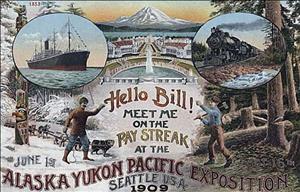At midnight on October 16, 1909, the Alaska-Yukon-Pacific Exposition (A-Y-P), held at the southern portion of the University of Washington campus in Seattle, closes after a 138-day run. The total attendance is 3,740,551 and the exposition will realize a profit of $14,488, which will be donated to the Anti-Tuberculosis League and the Seaman's Institute.
Elegant Buildings, Informative Exhibits, Sweeping Views
Similar to a World's Fair, the A-Y-P Exposition, which opened on June 1, 1909, was mandated by the state legislature to display the resources, products, and advantages of Washington and the region. It included exhibits in elegant buildings, along with fountains and formal gardens laid out with a panoramic view of Mount Rainier.
Among the exhibits was a perfect scale model of the Newcastle coal mine in King County southeast of Seattle, a zoo of native animals, and a replica of the New York home of William H. Seward (1801-1872), who negotiated the purchase of Alaska.
The Olmsted Brothers landscape firm laid out the fairgrounds with the idea that the plan would also guide development of the University of Washington campus after the exposition. The keystone of the original Olmsted scheme survives today as the lawn of "Rainier Vista" (originally a long, descending series of waterfalls) and Drumheller Fountain, better known as "Frosh Pond," which frame a dramatic view of Mount Rainier when weather permits.
Before the exposition, there were six buildings on the University of Washington campus. The university gained an additional 20 buildings from the Alaska-Yukon-Pacific Exposition. One hundred years after the fair closed, four buildings remained: the old Architecture Hall; the Washington Women's Building, renamed Cunningham Hall after photographer Imogen Cunningham (1883-1976); the Michigan Club Building, which became the Physical Plant Office Building; and the Power House.
Hurrah Day
The A-Y-P Exposition's final day, October 16, 1909, was designated Hurrah Day, but while the "intent was to cheer the monumental effort that had gone into creating and operating the fair, the event proved somber and bittersweet" (Stein and Becker, 131). The A-Y-P Band marched from building to building serenading the soon-to-be-dismantled exhibits, to the accompaniment of some tears and sobs. At the Government Building the flag was hauled down while the band played "Taps."
During the evening, attendees wandered the grounds or enjoyed a final visit to the exposition's popular Pay Streak amusements. With about an hour to go to the official closing hour of midnight, the band led a crowd of some 15,000 to the fair's amphitheatre.
A-Y-P President John Edward Chilberg (1867-1954) made an emotional speech, thanking the countries and states that had participated in the fair, the host city of Seattle, his staff, and Alaska. At midnight, he checked his watch and announced "The fair is at an end" (Stein and Becker, 131).
Chilberg flipped a switch and all the lights on the A-Y-P grounds went out. In the darkness a single bugler played "Taps" and the crowd then sang "Auld Lang Syne." With the lights back on, the crowd closed out the ceremony, and the fair, with a rousing 10-minute-long cheer.
Donating the Proceeds
When everything was tallied, the total attendance for the A-Y-P's four-and-a-half months stood at 3,740,551 and the gate receipts totaled $1,092,366.34. Unlike many prior expositions, the A-Y-P had money left over after all expenses were covered.
In June 1911, more than two years after the A-Y-P had opened, its executive committee met for the last time to decide how to distribute the $14,448 that remained after paying stockholders their final dividends. The sum of $366 was given to the Seaman's Institute while the Anti-Tuberculosis League of King County received the remainder of the A-Y-P profit.

